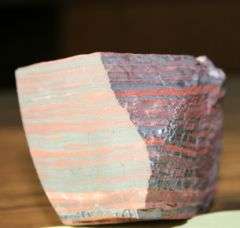A 2.8 billion-year-old piece of rock may hold a clue that unfolds the age old mystery behind the formation of iron.
(PhysOrg.com) -- Talk about a Cold Case. This mystery goes back to when there was no oxygen on the planet and bacteria were the most sophisticated life form. But Kurt Konhauser holds a clue to answering some ancient questions. It's a 2.8 billion-year-old piece of rock.
Konhauser is a professor in the Department of Earth and Atmospheric Sciences. The bookcase that lines his office at the University of Alberta is loaded with rock samples. Each one could be hiding secrets about the earliest days of the planet.
Konhauser holds a small orange-coloured rock up to the window. The daylight reveals thin lines of black streaking across the rock. The black lines are iron and by all rights shouldn't be there.
Konhauser is incredulous.
"How did iron get in a rock that dates back this far?"
He grabs a piece of paper, scribbling out a chemical formula, and continues talking. "You need oxygen in the ocean to oxidize the iron and 2.8 billion years ago there was no oxygen on the planet, so there had to be another way that iron was oxidized and turned into rock."
Konhauser's pride is plain to see. "We figured out how it happened."
It was bacteria, the only form of life on Earth at that time. The oceans were dense with photosynthetic bacteria and dissolved iron poured into the seas from active volcanoes. In this stew, iron became oxidized. Konhauser says 90 per cent of Earth's iron was produced this way. When prospectors find iron deposits today they can be as thin as a pencil line or massive bands or rock, hundreds of metres thick.
"This is one of the earliest examples of life interacting with the planet."
In addition to identifying the role of bacteria, Konhauser and his colleagues figured out why, over the course of millions of years, bands of iron deposits were intermittent, sometimes disappearing completely from the geological record.
Konhauser uses simple language to explain the phenomenon. "During spring and summer, when the bacteria are happy and active, they oxidize iron." And the reverse is true, he says: cold weather made the bacteria "unhappy" and oxidation shuts down. With that knowledge scientists can use the size and frequency of iron deposits to plot the climate changes that affected the young planet. "Happy" bacteria could work feverishly for decades, and then vanish for just as long.
Konhauser and his colleagues from Germany published their finding this month in Nature Geoscience. He's hopeful more breakthroughs are coming.
"We have a good idea of how life affects Earth today and now a new window about the massive effects the simplest form of life had on this planet. How it changed Earth and it still impacts us today."
Provided by University of Alberta
























